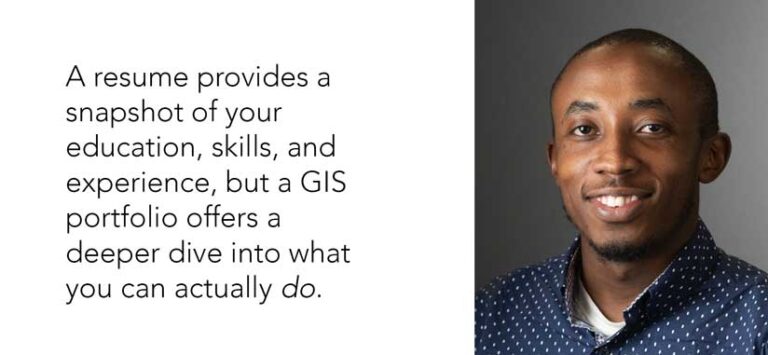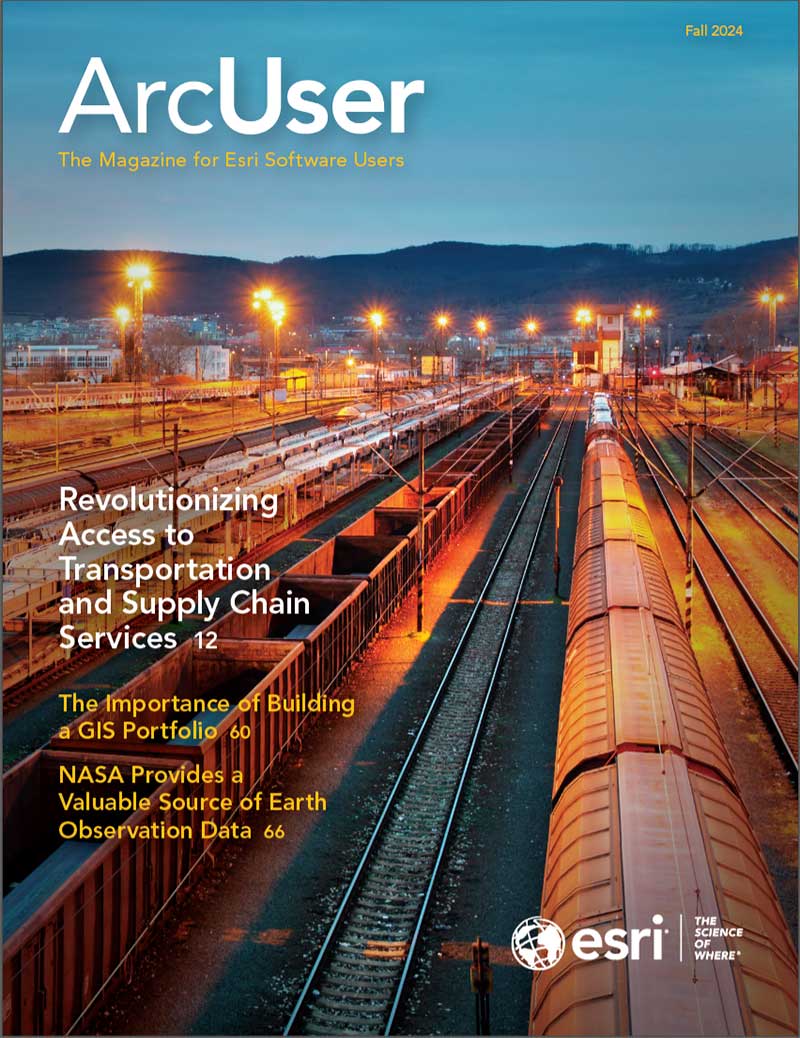As a student or emerging GIS professional, what can you do to stand out from others in this dynamic field? One of the most powerful tools you can leverage is a well-crafted GIS portfolio. A GIS portfolio is more than just a collection of your work—it’s a showcase of your skills, a reflection of your professional journey, and a crucial component in building a successful career in GIS.
Something More than Just a Resume
A resume provides a snapshot of your education, skills, and experience, but a GIS portfolio offers a deeper dive into what you can actually do. It’s the difference between telling and showing. While a resume might list “proficiency in ArcGIS” as a skill, a portfolio can demonstrate this proficiency through detailed examples of projects you’ve completed, maps you’ve created, and problems you’ve solved using GIS technology.
Your GIS portfolio should include a variety of work samples that highlight your capabilities across different areas of GIS. These samples might include:
Maps and Visualizations: High-quality maps that demonstrate your ability to analyze spatial data and present it in a clear, compelling manner.
Project Descriptions: Detailed write-ups of the projects you’ve worked on, including the challenges you faced, the solutions you implemented, and the impact of your work.
Data Analysis: Examples of your ability to analyze and interpret spatial data, using tools such as ArcGIS or other GIS software.
Programming and Automation: If applicable, include scripts or code snippets that show your ability to automate GIS tasks or perform advanced spatial analysis.
By including these elements, your portfolio becomes a powerful tool that not only highlights your technical skills but also tells the story of your professional journey in GIS.
Building Your Portfolio
Creating a GIS portfolio might seem daunting, especially if you’re early in your career and don’t yet have a wealth of experience to draw from. However, with a strategic approach, you can build a portfolio that effectively showcases your potential.
1) Start with What You Have
Don’t wait until you’ve accumulated years of experience before you start building your portfolio. Start with the projects you’ve completed during your education or any internships you’ve done. Even classroom assignments can be valuable portfolio pieces if they demonstrate your skills and your ability to solve real-world problems.
2) Choose a Platform
Your GIS portfolio needs a home, and there are several platforms you can use to create it. Websites like GitHub, Behance, or even a personal website can serve as a platform for your portfolio. Esri’s ArcGIS StoryMaps, ArcGIS Experience Builder, or ArcGIS Hub are excellent tools that allow you to create interactive, visually compelling narratives that showcase your work.
3) Showcase a Variety of Skills
When selecting projects for your portfolio, aim for diversity. Include projects that demonstrate your proficiency with different GIS tools and techniques, from spatial analysis and geocoding to data visualization and programming. This not only shows potential employers the breadth of your skills but also your adaptability in different areas of GIS.
4) Provide Context
A map or a data visualization on its own might look impressive, but without context, it’s just a pretty picture. For each project in your portfolio, provide a brief description that explains the problem you were trying to solve, the methods you used, and the results you achieved. This context is crucial for helping potential employers understand the impact of your work.
5) Keep It Updated
Your portfolio should be a living document that evolves as your career progresses. Make it a habit to update your portfolio regularly with new projects and skills. This not only keeps your portfolio fresh but also serves as a reminder of your growth and accomplishments in the field.
Leveraging Your Portfolio
Once you’ve built your GIS portfolio, the next step is to leverage it in your job search and career development. These strategies will help you make the most of your portfolio.
> Use it in job applications.
When applying for GIS positions, include a link to your portfolio in your resume and cover letter. This allows potential employers to see firsthand what you can do, rather than just reading about it.
> Bring it to interviews.
In an interview, your portfolio can be a powerful tool for demonstrating your skills and experience. Consider bringing a tablet or laptop to the interview so you can walk the interviewer through your portfolio and discuss the projects in detail.
> Share it on professional networks.
Platforms like LinkedIn are great for sharing your portfolio with a wider audience. Post updates about new projects you’ve added to your portfolio and include a link to your portfolio in your LinkedIn profile. This increases your visibility and can attract potential employers or collaborators.
> Use it for networking.
When networking at conferences or industry events, your portfolio can serve as a conversation starter. Whether you’re talking to potential employers or peers in the industry, being able to show them your work can leave a lasting impression.
Real-World Results from a GIS Portfolio
A close friend of mine, Mathew Ugwuanyi, is an example of a GIS professional who used his portfolio to successfully land a full-time GIS technician position at Highlands County Board of County Commissioners in Florida. His work, skills, and expertise were captured and presented in an ArcGIS StoryMap story and YouTube video. He updated his portfolio with projects that showcased his ability to analyze and visualize data related to health, crime, emergency response, and urban expansion potential. His portfolio demonstrated his versatility and ability to apply his GIS skills in a new context, which helped him stand out in the job market.

As a recent GIS graduate, I have used my GIS portfolio to land multiple awards, assistantships, and leadership roles. My portfolio included detailed maps, analyses, scripting/coding snippets, media coverage/representation, and publications that I had completed during my academic work, research, and profession. I can confidently say that recruitment managers have been impressed with the quality of my work and the way I have documented my problem-solving process.
I have always included my GIS portfolio in every application package I submit. This has paved the way for opportunities, such as working as an Esri User Conference student assistant and serving as a judge and reviewer for competitions held by the Ohio Academy of Science and the Virginia Junior Academy of Science.
You can take a look at my GIS portfolio.
In the competitive and ever-evolving field of GIS, having a well-crafted portfolio is not just an option—it’s a necessity. It serves as a powerful tool for showcasing your skills, telling your professional story, and navigating your career path. Whether you’re just starting out or looking to make a career transition, your portfolio can help you stand out, demonstrate your value, and open doors to new opportunities in the geospatial industry.
As you continue to build your career in GIS, remember that your portfolio is a reflection of your journey. Keep it updated, use it strategically, and let it be your compass as you navigate the exciting world of GIS.
I hope you find this article exciting and motivating. If a GIS portfolio helped you navigate your career trajectory, feel free to connect with me on LinkedIn.




